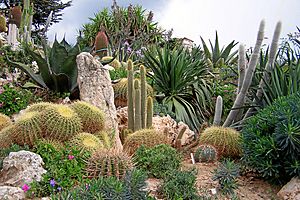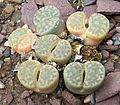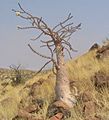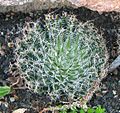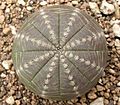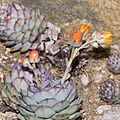Succulent plant facts for kids
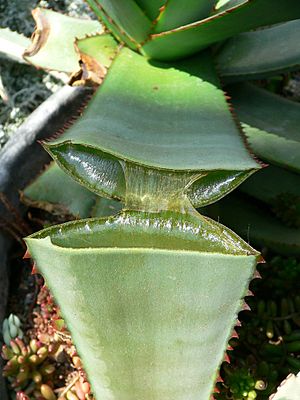
Succulent plants are plants that have adapted to very dry climates. They have adapted in such a way that they can store water, either in their leaves, stems or roots. Very often, they look different than plants that do not do this. Their leaves may look more fleshy. A very good example of succulents are the cacti. Almost all cacti are succulents. Not all succulents are cacti though. Other plant families with this property are the agavaceae (Agave family), Azioaceae and Crassulaceae. Other well-known succulents are the Aloe and the Bottle tree.
Contents
Appearance
The storage of water often gives succulent plants a more swollen or fleshy appearance than other plants, a characteristic known as succulence. In addition to succulence, succulent plants variously have other water-saving features. These may include:
- Crassulacean acid metabolism (CAM) to minimize water loss
- absent, reduced, or cylindrical-to-spherical leaves
- reduction in the number of stomata
- stems as the main site of photosynthesis, rather than leaves
- compact, reduced, cushion-like, columnar, or spherical growth form
- ribs enabling rapid increases in plant volume and decreasing surface area exposed to the sun
- waxy, hairy, or spiny outer surface to create a humid micro-habitat around the plant, which reduces air movement near the surface of the plant, and thereby reduces water loss and creates shade
- roots very near the surface of the soil, so they are able to take up moisture from very small showers or even from heavy dew
- ability to remain plump and full of water even with high internal temperatures (e.g., 52 °C or 126 °F)
- very impervious outer cuticle (skin)
- mucilaginous substances, which retain water abundantly
Habitat
Other than Antarctica, succulents can be found within each continent. While it is often thought that most succulents come from dry areas such as steppes, semi-desert, and desert, the world's driest areas do not make for proper succulent habitats. Australia, the world's driest continent, host very few native succulents due to the frequent and prolonged droughts. Even Africa, the continent with the most native succulents, does not host many of the plants in its most dry regions. However, while succulents are unable to grow in these harshest of conditions, they are able to grow in conditions that are uninhabitable by other plants. In fact, many succulents are able to thrive in dry conditions, and some are able to last up to two years without water depending on their surroundings and adaptations. Succulents may also occasionally occur as epiphytes, growing on other plants with limited or no contact with the ground, and are dependent on their ability to store water and gain nutrients by other means; this niche is seen in Tillandsia. Succulents also occur as inhabitants of sea coasts and dry lakes, which are exposed to high levels of dissolved minerals that are deadly to many other plant species. Potted succulents are able to grow in most indoor environments with minimal care.
Images for kids
-
The Lithops looks like a stone, but is in fact a plant. It also stores water in its leaves.
-
The bottle tree stores water in its trunk, that looks like a bottle
-
Prickly pear is a kind of cactus
-
Cactaceae: Rebutia muscula, stem succulent
-
Crassulaceae: Crassula ovata, stem and leaf succulent
-
Euphorbiaceae: Euphorbia obesa ssp. symmetrica, stem succulent
-
Cylindropuntia imbricata: stem, woody succulent
-
Malvaceae: Adansonia digitata, stem succulent
-
Asparagaceae: Beaucarnea recurvata, stem succulent
-
Asparagaceae: Dracaena draco, stem succulent
See also
 In Spanish: Suculenta para niños
In Spanish: Suculenta para niños


